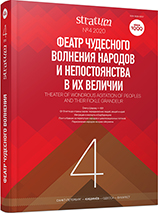Город Ольвия: черняховский горизонт. Керамика из фондов Института археологии НАНУ
Olbia Town: Chernyakhov Level. Ceramics from the Funds of the Institute of Archeology of NASU
Author(s): Boris V. MagomedovSubject(s): History, Archaeology, Ancient World, Migration Studies
Published by: Издательский дом Stratum, Университет «Высшая антропологическая школа»
Keywords: Northern Black Sea region; Olbia; Late Roman period; Migration period; Goths; Chernyakhov culture; amphora; red slip ware
Summary/Abstract: The presence of the population of Chernyakhov culture in Olbia in the final period of its history (second half of the 3rd — beginning of the 5th c.) has long been a contentious issue, although corresponding archaeological finds were known. A large amount of materials from this period practically has not been systematized, and it was not introduced sufficiently into scientific circulation. We have processed collections of the excavations of 1964—1971 on the territory of the Roman citadel, which were stored in the Institute of Archeology of the National Academy of Sciences of Ukraine (Kiev). Gray clay pottery from the collections are fully consistent with the “classic” Chernyakhov samples. These are fragments of tableware (including three-handed vases), kitchen pots, pithoi. They are accompanied by imported ceramics (amphorae and red slip ware) of the second half of the 4th — first half of the 5th c.Archaeological materials show that after the destruction of the town by the barbarians and desolation in the 70s — early 80s of the 3rd c., there appears a small number of Chernyakhov population. But only after the invasion of the Huns in Eastern Europe (375) Olbia revived as a small fortified town, a trade and craft center inhabited by Goth barbarians. This assumption needs to be confirmed by studying the existing collections of the Olbia Reserve.
Journal: Stratum plus. Археология и культурная антропология
- Issue Year: 2020
- Issue No: 4
- Page Range: 219-226
- Page Count: 8
- Language: Russian
- Content File-PDF

